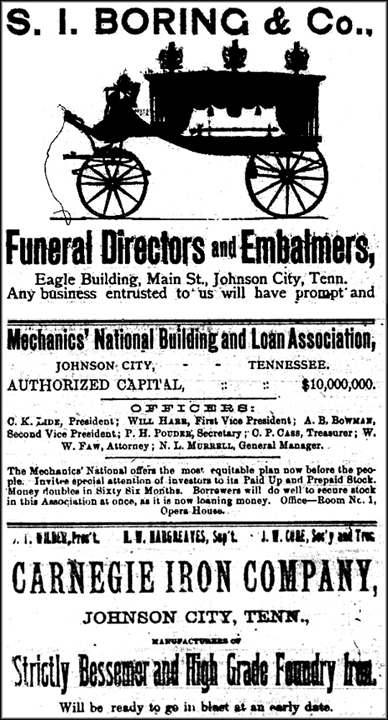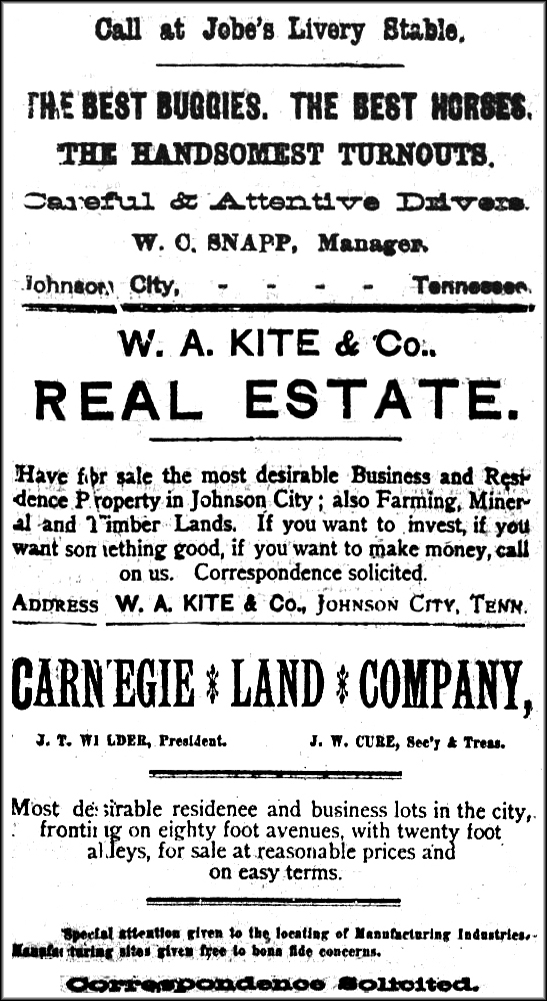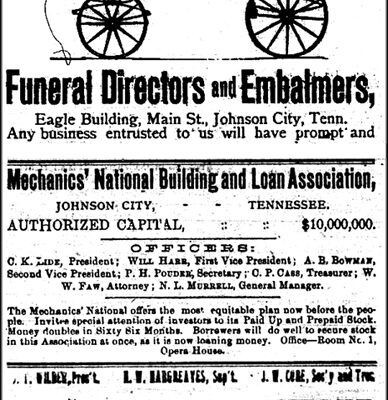An oft-repeated article in the 1891 edition of an early Johnson City newspaper, The Comet, promoted the town as being a great place to reside. According to a Dec. 1891 depiction, the city had several taglines: “Center of Trunk Lines and Terminal Roads,” “Gateway to the Mineral and Timber-Laden Alleghenies” and “In the Heart of the Celebrated Magnetic Ore District.”
The publication noted that Johnson City was located 106 miles northeast of Knoxville at the intersection of two great trunk lines, the East Tennessee, Virginia and Georgia Railroad and the Charleston, Cincinnati and Chicago Railroads. It was also at the termini of the East Tennessee and Western North Carolina and the Johnson City and Carolina Railroads.
The Johnson City and Greensboro Railroad, an extension of the Richmond and Danville line from Greensboro to Johnson City via Wilkesboro, had been chartered and a preliminary survey made. In addition, the Johnson City and Cumberland Gap Railroad Co. had been organized.
The Southern and Eastern Line was building from Shelby and Cranberry to connect with the East Tennessee and Western North Carolina Railroad. While Johnson City was not considered to be a speculative town, it was a substantial young city whose progress within the past two years bore favorable comparison with many other cities in the South. It was in the midst of an excellent agricultural section.

Cereals, tobacco, grasses and a variety of fruits grew to perfection. There was no better section for the stockman, the cattle breeder, or the fruit grower. Also, it had at its door an unlimited supply of the finest timber obtainable. Nearly all of the hardwood abounded in vast quantities, an excellent source for wood working plants of every description.
The town was literally hedged in by mountains of iron ores, with red and brown hematite abounding in seemingly inexhaustible quantities. It was situated near the base of the Cranberry Mountains, whose celebrated magnetic ores were its natural outlet. Its proximity to the magnetic ores of the east and coalfields on the west certainly made it the steel-making center of the South. Limestone was found here in quantities beyond estimation and of the best quality.
The city, with an altitude of 1650 feet above sea level, was noted to be very healthful and was growing in leaps and bounds. The population, according to the 1890 census, was 4160, an enormous 507% increase over the 1880 one, when it was only 685.
In December 1891, the following enterprises were either in operation or being constructed: Johnson City Tin and Stove Co. (manufacturers of tinware), W.C. Remine (marble yard), Johnson City Foundry and Machine Works, Johnson City Furniture Co., Watauga Electric Lighting and Power Company, Johnson City and Carnegie Street Railroad Co., Watauga Tanner, Carnegie Iron Company (with a 125-ton blast furnace), Brown and Biddle (125-barrel process flouring mill), Miller Brothers (machine shop and foundry), Crandall-Harris (tobacco factory), J.E. Harr (cigar factory), W.J. Graham & Co. (ice factory and bottling works), Johnson City Brick Works, S.F. Ivina & Co. (brick works), J.T. Hoss & Co. (brick works), Allison & Shafer (brick works), Campbell & Co. (brick works), Johnson City Canning Factory (A.B. Bowman), Watauga Lumber Company, Cooper Brothers (planing mill), J.M. Carr & Co. (planing mill), John Sanders (planing mill), Fishback & Weiger (bakery), City Steam Laundry, Browning & Co. (soap factory) and Watauga Water Co.
The Comet identified several city officials. The Johnson City Law Court, which convened the third Monday of April, August and December, was comprised of A.J. Brown (judge), S.H.L. Cooper (clerk) and P.H. Pouder (deputy clerk). The Johnson City Chancery Court, which met on the first Monday in June and December, consisted of the Honorary John P. Smith (judge), A.B. Bowman (c and m) and P.H. Pouder (deputy c and m).

Corporation offices convened on the First Thursday of each month. They were filled by Ike T. Jobe (mayor), George P. Crouch (recorder), Robert Ramine (chief of police), A.R. Johnson (city attorney), R.C. Hunter (city constable) and Dr. R.S. Bolton (city physician).
J.M. Martin was postmaster. The post office was open weekday from 8:00 a.m. until 7:00 p.m. It was closed on Saturdays but open on Sunday 7:00 a.m. to 8:20 a.m., 1:30 p.m. to 3:30 p.m. and 4:30 p.m. to 5:30 p.m. The Money Order Department conducted business on weekdays from 8:00 a.m. to 4:00 p.m.
The Board of Trade consisted of William G. Mathes (president) and Cy H. Lyle (secretary, publisher of The Comet). They met each Monday evening at an unspecified location on E. Main Street.
Three train schedules were posted in the newspaper. The first was the East Tennessee and Western North Carolina Railroad. One of four westward/eastward routes showed it leaving Johnson City at 7:45 a.m., traveling to Milligan College, Watauga Point, Gladeland (flag station), Elizabethton, Valley Forge (flag station), Hampton, Pardee Point (flag station), Blevins, White Rock, Crab Orchard (flag station), Roan Mountain, Shell Creek, Elk Park, Hotel and arriving in Cranberry at 11:15 a.m.
The second schedule was for the Charleston. Cincinnati and Chicago Railroad. One of the four north routes timetables had it leaving Ranges at 4:00 p.m., going to Harrisburg, Austin Springs and arriving at Carnegie at 4:50 pm. After a two-hour stopover, it continued on to Main Street in Johnson City, Okalona (Okolona), Fagans, Marbleton, Unicoi and Erwin at Unaka Springs.
The third schedule showed the East Tennessee, Virginia and Georgia Railroad. Three times a day, the train left Johnson City going west for Knoxville, Cleveland and Chattanooga. In addition, three trains left Johnson City heading toward Bristol and points east.
Finally, ten churches were listed: M.E. Church South (K.C. Atkins), Watauga Sunday School at Lusk’s Institute (J.W. Crumley), M.E. Church (G.W. Coleman), Presbyterian Church (J.C. Cowan), Baptist Church (East Carnegie Baptist Church (J.H. Snow), Christian Church (D.T. Buck), Carnegie Mission Methodist Church (T.S. Russell), Episcopal Mission (W.C. Wells) and Cumberland Presbyterian Mission Church (T.B. McAmis).
The Comet was a quality publication offering a glimpse of mostly long-forgotten history from yesteryear.
